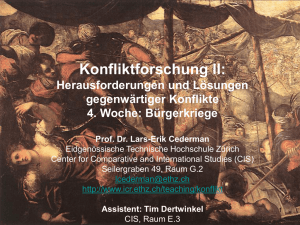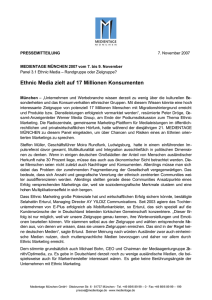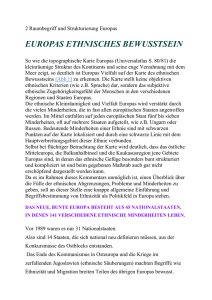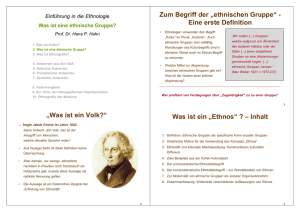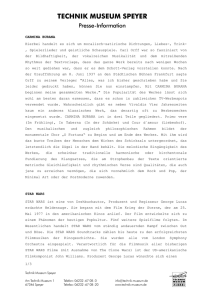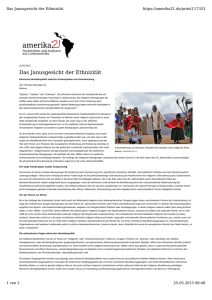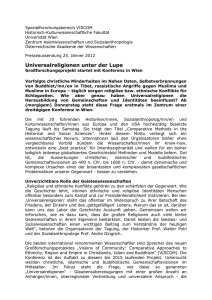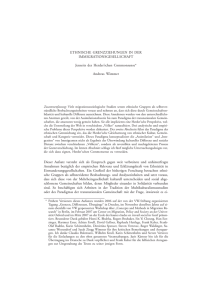N - International Conflict Research
Werbung
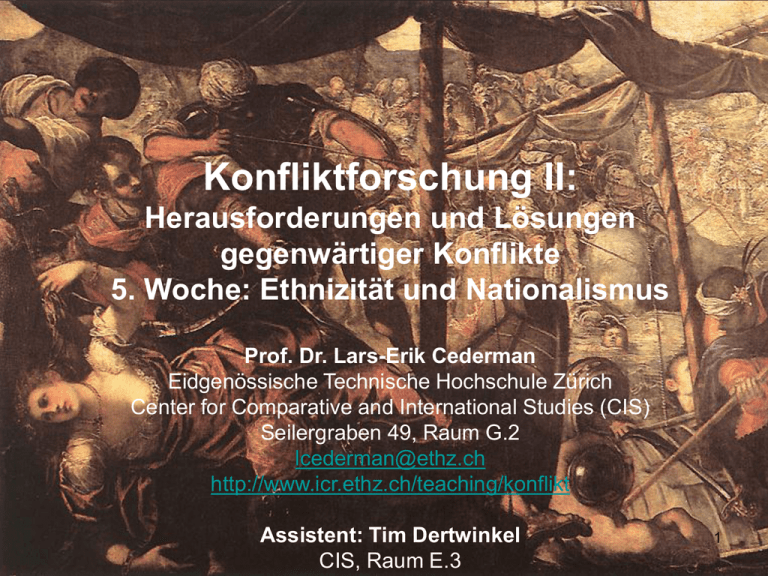
Konfliktforschung II: Herausforderungen und Lösungen gegenwärtiger Konflikte 5. Woche: Ethnizität und Nationalismus Prof. Dr. Lars-Erik Cederman Eidgenössische Technische Hochschule Zürich Center for Comparative and International Studies (CIS) Seilergraben 49, Raum G.2 [email protected] http://www.icr.ethz.ch/teaching/konflikt Assistent: Tim Dertwinkel CIS, Raum E.3 1 Gliederung: Ethno-Nationalismus 1. Definitionen 2. Kriegsursachen • • • • Keine Wirkung Frustrationstheorien Sicherheitsdilemma Makroprozesse 3. Lösungsansätze 2 1. Definitionen • „Wir wollen solche Menschengruppen, die aufgrund von Ähnlichkeiten des äußeren Habitus oder der Sitten oder beider, oder von Erinnerungen an Kolonisation und Wanderung einen subjektiven Glauben an eine Abstammungsgemeinschaft hegen, ... ethnische Gruppen nennen, ganz einerlei, ob eine Blutgemeinschaft vorliegt oder nicht.“ • Die Nation „ist eine gefühlsmässige Gemeinschaft, deren adäquater Ausdruck ein eigener Staat wäre, die also normalerweise die Tendenz hat, einen solchen aus sich hervorzutreiben“. Max Weber 3 Ethnische Bürgerkriege • Sambanis 2001 definiert sie als „episodes of violent conflict between governments and national, ethnic, religious, or other communal minorities (ethnic challengers) in which the challengers seek major charges in their status ... Rioting and warfare between rival communal groups is not coded as ethnic warfare unless it involves conflict over political power or government policy.” 4 2. Bürgerkriegstheorien • Ethnizität unwichtig – Ökonomische Theorien – Neue Kriege • Ethnizität wichtig: – Frustrationstheorien – Sicherheitsdilemma – Makroprozesse 5 (a) Frustrationstheorien • Minorities at Risk (Ted Gurr) • State Failure Task Force: http://www.cidcm.umd.edu/inscr/stfail/ • State failure = – – – – revolutionäre Kriege ethnische Kriege undemokratische Regierungswechsel Genozide und Politizide • Trotz eines gewissen Rückgangs bleiben die ethnischen Kriege die häufigste Form bewaffneter Konflikte 6 (b) Sicherheitsdilemma • Drei Typen: – Zwischenstaatliche (Herz, Jervis) – Innenstaatliche (Walter, Wallensteen) – Innenstaatliche ethnische (Posen) • Posen 1993: „Emerging anarchy“ Barry Posen, MIT – Nach dem Zerfall multinationaler Staaten entsteht eine anarchische Situation, die besonders gefährlich ist: • die Offensive dominiert • die Grenzen sind unklar • ethnische Mythen führen zu Konflikten 7 (c) Makroprozesse I • Ethnische Konflikte werden als Nebeneffekte von historischen Makroprozessen interpretiert • Michael Mann: Modernisierung und Demokratisierung Ethnische Säuberungen im grossen Stil hängen von Staaten- und Nationenbildung ab: • Minderheiten mit einer guten Chance • Eher bedrohte als zerfallene Staaten Michael Mann, UCLA 8 (c) Makroprozesse II • Bei Andreas Wimmer steht der Kampf um die Staatsmacht im Zentrum • Wo es einer Gruppe gelingt, die anderen auszuschliessen, folgt oft Gewalt • Risiko besonders gross in demokratischen Mehrheitsregierungen und repressiven Regimen Andreas Wimmer UCLA 9 Beyond Fractionalization: Mapping Ethnicity onto Nationalist Insurgencies Lars-Erik Cederman and Luc Girardin Swiss Federal Institute of Technology, Zurich (ETH) http://www.icr.ethz.ch Prepared for the conference “Disaggregating the Study of Civil War and Transnational Violence.” IGCC, UCSD, March 7-9, 2005 10 Research Problem • Using various indices, esp. the ELF, political economists dismiss ethnicity as an explanation of civil wars • But the indices lack micro-foundations: Pr(Civil Conflict) = E(M) • We present a new index that we call N* • Based on this index, ethno-nationalist mechanisms become significant 11 Existing indices The ethno-linguistic fractionalization index: E Mij n ELF 1 s i 1 2 i sj si A polarization index: 1 n 2 RQ 1 1 / 2 si si 4 i 1 12 Ethno-nationalist civil wars Drawing on Gellner, Mann and Wimmer, we formulate an ethno-nationalist explanation of civil violence: • A1. Conflict over ownership of the state • A2. Conflict at the group level Violence is likely to erupt when ethnonationalist groups claim the same territory and their chances of succeeding are good 13 Constructing the N* index State-centric ethnic configuration E*: p(1) Micro-level mechanism M*: s1 p(2) s0 p(i) 1 p (i ) 1 {r (i ) r} k s2 … p(n-1) sn-1 n 1 Pr(CivilConflict ) 1 1 p (i ) i 0 r(i)= si si s 0 14 Defining the N*(r,k) index k r (i ) / r N * (r , k ) 1 k i 0 1 r (i ) / r n 1 si r (i ) si s0 where ELF RQ N*(0.5,5) {0.5 0.5} 0.5 1.0 0.5 {0.7 0.3} 0.42 0.84 0.072 {0.3 0.7} 0.42 0.84 0.843 {0.3 0.3 0.2 0.2} 0.74 0.76 0.716 {0.2 0.3 0.3 0.2} 0.74 0.76 0.959 {0.2 0.2 0.2 0.2 0.2} 0.78 0.64 0.937 Examples of states: 15 Coding the N* index • We define an EGIP (Ethnic Group In Power) as a group (or a coalition of groups) whose leaders serve (at least intermittently) in senior governmental positions • We coded the N* index for Eurasia and North Africa, leaving other parts of the world for future research • The appendix presents the coding for 88 states 16 1 Comparing the ELF and N* indices .8 Irak United Arab Emirates Lebanon .4 N* .6 Jordan .2 Kuwait Kazakhstan Afganistan Bosnia Bhutan Morocco Latvia 0 Moldova 0 .2 Iran Estonia Malaysia Tajikistan Indonesia USSR India Yugoslav .4 .6 .8 ELF 17 ELF values for Eurasia & N. Africa 18 N* values for Eurasia & N. Africa 19 Logit Regressions: Civil wars Model 1 Prior war Model 2 Model 3 Model 4 -1.024 (0.42) -0.963 (0.409) -1.024 (0.409) -1.023 (0.409) -0.305 (0.082) -0.315 (0.081) -0.336 (0.084) -0.336 (0.084) log(population) 0.322 (0.105) 0.335 (0.103) 0.396 (0.105) 0.394 (0.106) log(% mountains) 0.259 (0.146) 0.275 (0.144) 0.261 (0.142) 0.265 (0.151) 0.043 (0.35) 0.165 (0.346) 0.168 (0.344) 0.169 (0.344) Oil exporter 1.331 (0.357) 1.35 (0.357) 1.321 (0.354) 1.319 (0.355) New state 2.018 (0.438) 1.998 (0.44) 2.072 (0.441) 2.075 (0.442) Instability 0.372 (0.351) 0.355 (0.352) 0.438 (0.353) 0.437 (0.353) Democracy 0.056 (0.024) 0.057 (0.023) 0.063 (0.024) 0.063 (0.024) Per capita income Noncontiguous state ELF N = 3,327 p<0.001 0.611 (0.599) RQ 0.522 (0.656) N* p<0.01 1.741 (0.66) r Constant Specification based on Fearon and Laitin (2003) 1.779 (0.818) 0.513 (0.158) -7.549 (1.131) -7.782 (1.174) -8.159 (1.16) -8.152 (1.163) p<0.05 20 Logit Regressions: Ethnic wars Model 5 Model 6 Prior war -1.253 (0.484) -1.292 (0.491) Per capita income -0.253 (0.088) -0.25 (0.088) 0.67 (0.125) 0.694 (0.131) log(% mountains) 0.192 (0.186) 0.139 (0.197) Noncontiguous state 0.637 (0.401) 0.654 (0.405) Oil exporter 1.136 (0.431) 1.111 (0.429) New state 2.312 (0.553) 2.295 (0.554) Instability 0.412 (0.456) 0.432 (0.456) Democracy 0.036 (0.029) 0.036 (0.03) N* 2.681 (0.793) 2.55 (0.788) log(population) r Constant N = 3,327 p<0.001 p<0.01 0.427 (0.087) -11.631 (1.467) -11.801 (1.499) p<0.05 21 Conclusions and extensions • ELF-based “tests” of ethnicity overlook nationalist configurations and mechanisms • It is therefore premature to reduce civil wars to materialist insurgencies • In future work, we will: – extend the coding to the whole world – introduce dyadic measures (e.g. geography) – use computational models to articulate mechanisms 22 3. Lösungsansätze • Staatenbildungskonflikte – dauern an, oder – enden mit • einem Sieg der Regierung • einem Sieg der Rebellen (Sezession oder Autonomie) • einer Verhandlungslösung • Siehe Wallensteen Kap. 7 23 Partition: eine drastische Lösung! • Kaufmann (1996) empfiehlt Partition „when all else fails“ weil Identitäten härten • Sambanis (2000) kritisiert Partition: – Empirisch (Verhandlungslösungen doch möglich) – Normativ (Freibrief für ethnische Säuberungen?) – Theoretisch (Instabilität?, Signal?, System?) Israels „Sicherheitszaun“ um die Westbank Aufteilung einer Bibliothek 1947 24 Gurrs hoffnungsvoller Trend • Gruppenrechte • Pluralismus und Machtteilung • Kompromisslösungen • Wirkungsvollere Instrumente der internationalen Organisationen 25
![program[]](http://s1.studylibde.com/store/data/002125064_1-584e267d6a9032c81e7cdbf743b3d983-300x300.png)
